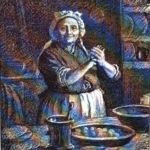Historic Recipes from the Jews of Alsace-Lorraine
by David P. Rosenberg, M.P.A., Reference Services Research Coordinator, Center for Jewish History
In my last blog post, I touched upon three upcoming events here at the Center for Jewish History:
- “Sex, Yiddish and the Law: Jewish Life in Metz in the 18th Century” (which concerns the “cultural, legal and sexual lives of members of the Metz Jewish community”) on Monday, October 21, 2013 at 6:30pm
- “Charles-Valentin Alkan: His Life and Music” (concert and lecture) on Monday, November 18, 201 at 8pm
- “French and Jewish: Defining a Modern Jewish Identity in the 19th Century” (roundtable discussion) on Monday, December 9, 2013 at 6:30pm
In looking into the food-culture of the Jews from Alsace-Lorraine, I learned about the importance of goose. According to Claudia Roden’s The Book of Jewish Food: An Odyssey from Samarkand to New York, force-feeding geese was economically important to the Jews of this region and dates to the 17th century.
Meat from birds that were bred and raised to provide foie gras was tough. As a result, it was sometimes used to make confit d’oie, a slow process involving garlic, onions, salt, fat and lots of time. Meat was also preserved by smoking. It was then sometimes eaten in traditional dishes such as cholent.
Goose fat also made its way into other traditional dishes such as lokshen kugel (egg noodle casserole) where goose fat replaced traditional schmaltz (chicken fat) or vegetable oil. Similarly, goose fat was occasionally used alongside corned beef or tongue, potatoes and sauerkraut in choucroute garnie, a dish that Alsace is known for.
Roden cites Suzanne Roukhomovsky’s Gastronomie Juive: Cuisine et pâtisserie … de Russie, d’Alsace, de Roumanie et d’Orient as the source for an interesting way to improve boiled tongue preparation. After the standard step of boiling the meat with spices for three hours to make it “very tender,” the Alsatian tradition calls for peeling off the skin and simmering the meat with white wine, sliced mushrooms and the original water (after it has been strained) for an additional half hour.
Geese were specifically bred to be at their prime for the Christians in the region to serve them at Christmas. Because Jews knew that the meat would be at its best during this general time, they often ate goose during Hanukkah. It was often prepared with a stuffing of apples, cabbage and chestnuts.
In my next blog post I’ll explore the economic life of Jews in Alsace-Lorraine and changes that came with emancipation – particularly with regard to their relationships with gentile neighbors. The program “French and Jewish: Defining a Modern Jewish Identity in the 19th Century” on Monday, December 9, at 6:30pm will address the striking metamorphosis.
To start my research, I looked at The Economic Status of the Jews in Alsace, Metz and Lorraine (1648-1789) and learned several interesting things:
- In the 17th century, Jews were required to wear a “yellow patch or another distinguishing mark reserved for Jews… Jewish children were converted to Catholicism by force…” (p.29).
- “They had to struggle to obtain permission for storing their merchandise and to have stable for their horses outside the ghetto limit"–perhaps one of the reasons geese were raised (p.43).
- Like in other places, usury was common among the Jews of Alsace-Lorraine. They often gave loans to peasants struggling to pay taxes.
- Jews themselves struggled to pay their taxes because they were levied disproportionately. For example, in Metz, Jews were 1/18th of the population but were forced to pay 1/6th of the capitation tax (p.71).
- Professional licenses were more expensive for Jews. They had to pay over double the cost of equivalent licenses purchased by gentiles. In 1715, Jews were charged 2,100 as compared to 1,000 pounds in one example given (p.71).
- Overall, “prior to 1789 the greatest part of Jews living in Lorraine were poor” (p68-9).
To learn more about our current exhibition, click here.
Above image: A cheerful older woman with covered hair making matzah balls. From the 1886 Leon Cahun work La Vie Juive.
–
This fall, the YIVO Institute and the Center for Jewish History present an exhibition, a symposium and four public programs that explore the Jewish community in Metz, France in the 18th and 19th centuries. These programs were inspired by the Pinkas (Register) of the Metz Rabbinic Court, a rare and little-known document from the collections of the YIVO Institute Archives.
The exhibition and program series is made possible by the generous support of The David Berg Foundation and Selz Foundation. Additional support has been provided by Emil Kleinhaus.

